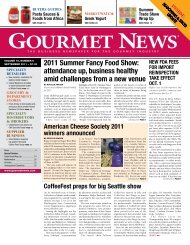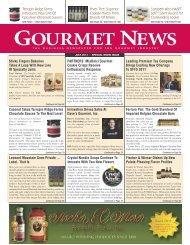June 2012 - Oser Communications Group
June 2012 - Oser Communications Group
June 2012 - Oser Communications Group
You also want an ePaper? Increase the reach of your titles
YUMPU automatically turns print PDFs into web optimized ePapers that Google loves.
6<br />
GENERAL NEWS<br />
GOURMET NEWS JUNE <strong>2012</strong> www.gourmetnews.com<br />
NRA<br />
Continued from PAGE 1<br />
Chef’s Brand Pacific Caught Wild Albacore,<br />
sustainable, preservative-free and<br />
better quality tuna in a pouch; wholegrain,<br />
high-protein Mara’s Pasta; Mfusions,<br />
a fruit-and-tea version of the<br />
vitamin-release water concept by premium<br />
tea company MightyLeaf; and SasaPops,<br />
artisan popsicles in pure fruit and<br />
dessert varieties.<br />
There was a striking variety of products<br />
designed for the new K-12 school<br />
lunch requirements, a foodservice parallel<br />
to the range of healthy kids’ products<br />
coming out on retailers’ shelves.<br />
(Membership in the NRA’s Kids Live<br />
Well initiative has quadrupled in size<br />
this year, according to the organization.)<br />
On the opposite end, restaurateurs<br />
also had their pick of creative<br />
bar foods—from tempura-battered<br />
spicy green beans, to fried “cheeseburger<br />
bites” made from ravioli by<br />
Carla’s Pasta to Sorghum, a bourbonlike<br />
spirit distilled from the grain.<br />
In terms of new forms and products,<br />
there was a rise in Greek yogurt and hummus<br />
options, as foodservice responded to<br />
customer requests for hot retail categories<br />
from 2011, and more interest in vegetable<br />
and herb flavors, but in in non-traditional<br />
categories like drinks and snacks.<br />
Coca-Cola’s Freelance machine,<br />
which allows customers to create<br />
their own sodas from more than 100<br />
options, continued to draw long<br />
lines despite repeated appearances at<br />
the show. The concept is now extending<br />
to shakes and slushes, with<br />
Vitamix showing a conveniencestore<br />
targeted machine that allow<br />
consumers to create and blend their own<br />
flavors of frozen drinks.<br />
There was also strong interest in providing<br />
gluten free foodservice, particularly<br />
for schools and universities. An<br />
education session by the National Foundation<br />
for Celiac Awareness, which trains<br />
restaurant and retail staff to serve the<br />
gluten free market, was well-attended and<br />
drew strong audience response. Gluten<br />
free specialists such as Bready, Schar and<br />
Conte reported strong interest at the<br />
show, and many mainstream manufacturers<br />
highlighted their gluten free options.<br />
With 7 out of 10 American consumers<br />
continuing to cook at home to save on going<br />
out (according to a Harris Interactive poll released<br />
in May <strong>2012</strong>), there is a clear need to<br />
find new areas of growth for consumer<br />
restaurants. While optimism and spirits<br />
were high, the challenges remained clear. As<br />
the lines between retail channels—and between<br />
retail and restaurant—continue to<br />
blur, customers are the clear winners. GN<br />
ORGANIC<br />
Continued from PAGE 1<br />
cated through the <strong>2012</strong> survey results, indicate<br />
that both organic food and non-food<br />
sales will continue to sustain growth levels<br />
of nine percent or higher.<br />
“With 94 percent of organic operations<br />
nationwide planning to maintain or<br />
increase employment in <strong>2012</strong>, the organic<br />
sector will continue to fuel jobs,<br />
rural economies and consumer choice,”<br />
said Bushway.<br />
Besides retail growth, organic food production<br />
also generated more than 500,000<br />
American jobs in 2010, thousands more<br />
jobs than conventional agricultural methods.<br />
This was contained in a second report,<br />
“2010 Impacts of the U.S. Organic Foods<br />
Industry on the U.S. Economy.”<br />
“This report sends a strong message that<br />
doing what’s good for the environment and<br />
The eight categories are dairy products,<br />
breads and grains, beverages, fruits and<br />
vegetables, snack foods, packaged and prepared<br />
foods, condiments and sauces, and<br />
meat, poultry and fish.<br />
Organic food sales now represent 4.2<br />
percent of all U.S. food sales, up from 4<br />
percent in 2010. Meanwhile, organic<br />
non-food sales, representing the personal<br />
care and cleaning sections of many natural<br />
product retailers, reached $2.2 billion<br />
in 2011, experienced strong 11<br />
percent growth, versus 5 percent growth<br />
for total comparable non-organic items.<br />
Prospects for <strong>2012</strong> and 2013, as indiwhat’s<br />
good for industry economics are not<br />
mutually exclusive,” said Congressman<br />
Sam Farr (CA-17), an industry advocate.<br />
The report, produced for OTA by Washington,<br />
D.C.-based M+R Strategic Services,<br />
showed that for every $1 billion in<br />
retail sales of organic products, 21,000<br />
more jobs were created throughout the<br />
economy. In addition, the use of organically<br />
produced ingredients resulted in the<br />
creation of 21 percent more jobs than<br />
would have been generated if the food industry<br />
had relied solely on conventional<br />
farms for its ingredients.<br />
The study attributed the job-creation differences<br />
largely to greater labor intensity on<br />
organic farms, smaller farm size, the need<br />
for an organic certification industry, and reliance<br />
on smaller retail outlets.<br />
The release of the jobs report comes as<br />
Congress shapes the next farm bill, the nation’s<br />
major food and agriculture policy legislation.<br />
Included in the bill are programs<br />
(and funding) critical to facilitating the expansion<br />
of U.S. organic farming.<br />
“This report and OTA’s <strong>2012</strong> Organic Industry<br />
Survey released this week reinforce<br />
the positive contributions of the organic<br />
sector to U.S. agriculture and our economy,”<br />
said the OTA’s Christine Bushway.<br />
“The message is clear—federal organic<br />
food and agriculture programs are jobcreation<br />
programs.”<br />
The OTA is the membership-based<br />
business association for organic agriculture<br />
and products in North America. It<br />
represents over 6,500 organic businesses<br />
across 49 states. GN
















